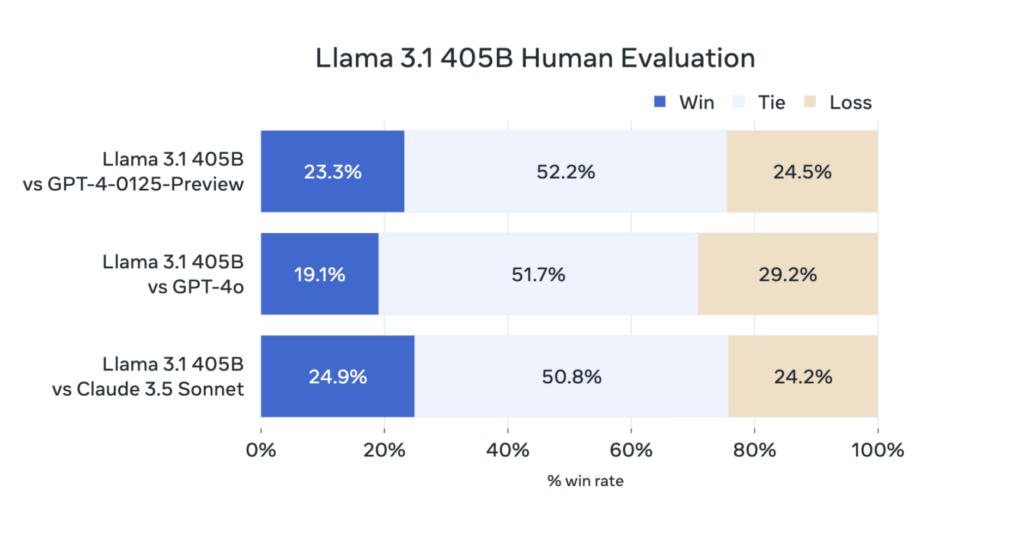
Breaking News: Meta Unveils Llama 3.1 405B Model – A Game-Changer in AI Development
Meta has launched its most advanced AI language model yet, the Llama 3.1 405B, featuring an astonishing 405 billion parameters. This model not only rivals but potentially outperforms leading proprietary models like OpenAI’s GPT-4 across various benchmarks. The introduction of this model signifies a pivotal moment in AI technology, with far-reaching implications for the future.
What Makes Llama 3.1 405B So Special?
The Llama 3.1 405B model is distinguished by its 128K token context window, which is 16 times larger than its predecessor. This expanded context window allows the model to handle complex, context-rich tasks more efficiently. The model supports eight languages—English, German, French, Italian, Portuguese, Hindi, Spanish, and Thai—broadening its utility and accessibility.
Moreover, Llama 3.1 405B is designed with multimodal capabilities, meaning it can process and generate content across different types of data inputs, such as text and images. This feature significantly enhances the model’s versatility and application scope, setting a new standard in the open-source AI landscape.
Benchmarks and Performance

Llama 3.1 405B has shown exceptional performance in various benchmarks, including general knowledge, long-form text generation, multilingual translation, coding, math, and advanced reasoning. It outperforms GPT-4 in GSM8K and Hellaswag tests while being competitive in other areas such as HumanEval and MMLU-social sciences. This diverse performance spectrum highlights the model’s potential to revolutionize multiple industries, from education to entertainment.
Training and Availability

The model was trained using over 16,000 NVIDIA H100 GPUs and processed more than 15 trillion tokens. This massive computational effort has made the model one of the most advanced open-source AI systems available. Llama 3.1 405B is accessible on platforms like Hugging Face, AWS, Azure, Google Cloud, and Meta’s own AI chatbot. This broad availability democratizes access to cutting-edge AI technology, allowing developers and researchers to innovate without the constraints of proprietary systems.
The Significance of Open-Source AI Development

Meta’s decision to release Llama 3.1 405B as an open-source model marks a significant shift in the AI industry. Open-source development promotes transparency, collaboration, and innovation. By making the model and its weights publicly accessible, Meta enables a wider range of developers to explore advanced AI capabilities, potentially leading to breakthroughs in various fields.
However, the open-source nature of such powerful models also raises concerns about misuse, security, and ethical considerations. The ease of access to highly advanced AI tools could lead to issues like deepfakes, privacy breaches, and the perpetuation of bias if not managed responsibly. As the industry grapples with these challenges, the need for robust governance and ethical frameworks becomes increasingly apparent.
Implications for the Future
The release of Llama 3.1 405B could democratize AI research and development, allowing a broader range of contributors to shape the future of AI. However, it also poses significant questions about the ethical use of AI technology, particularly in areas like data privacy and bias. As regulatory bodies, like the European Union with its AI Act, begin to establish guidelines, the landscape of AI development will likely undergo significant changes.
The competition in the AI space is also intensifying. With Meta’s open-source approach and OpenAI’s continued dominance, the industry is seeing a fascinating juxtaposition of open and closed systems. The impact of these strategies will be crucial in determining the future direction of AI technologies.
Case Studies and Practical Examples
To illustrate the potential of Llama 3.1 405B, consider its application in healthcare for personalized medicine. Researchers can use the model to analyze vast datasets of medical literature, identifying trends and potential treatments that would be impossible to discern manually. In education, the model’s multilingual capabilities can support real-time translation and content generation, making quality education more accessible worldwide.
Expert Opinions
AI experts like Andrew Ng and Fei-Fei Li have emphasized the importance of accessibility in AI development. Ng recently noted that “open-source models like Llama 3.1 405B democratize access to cutting-edge AI, allowing a broader base of talent to innovate and contribute.” This sentiment is echoed by Li, who believes that “collaborative, open-source efforts are crucial for ensuring AI develops in a way that benefits all of humanity.”
Conclusion
Meta’s Llama 3.1 405B model represents a groundbreaking advancement in AI research and development. By embracing an open-source model, Meta is fostering an environment of collaboration and innovation. However, the implications of such a move require careful consideration to ensure that AI technologies are developed and deployed responsibly.
This model could significantly impact various industries and open new frontiers in AI capabilities. As we navigate this new era, the balance between innovation and ethical responsibility will be crucial to harnessing the full potential of AI for the benefit of humanity.
 Meta’s Llama 3.1 405B – A New Era in AI
Meta’s Llama 3.1 405B – A New Era in AI